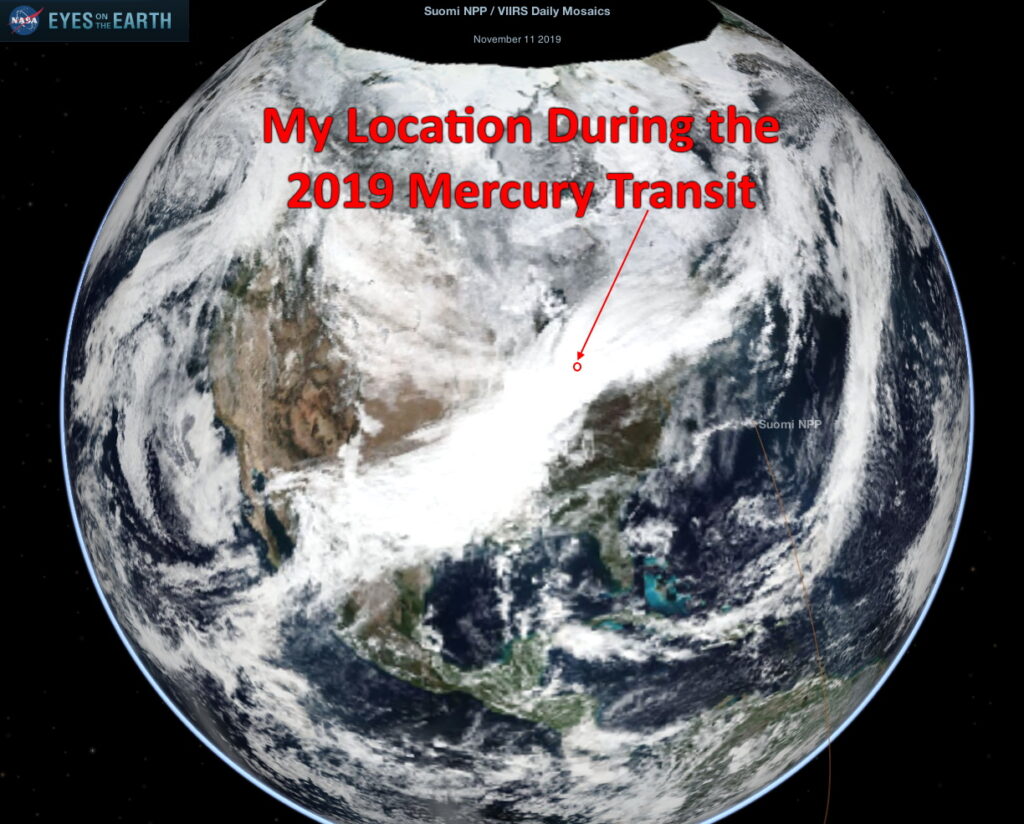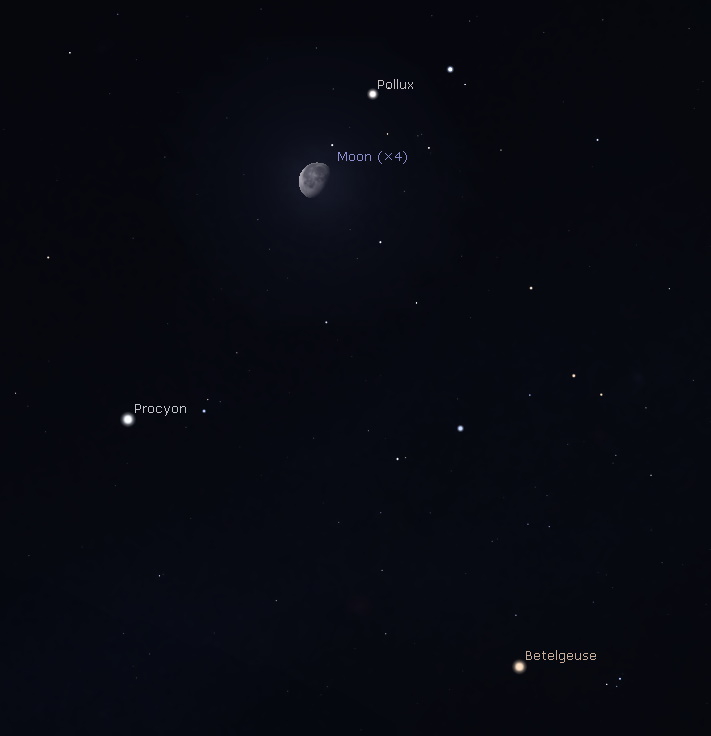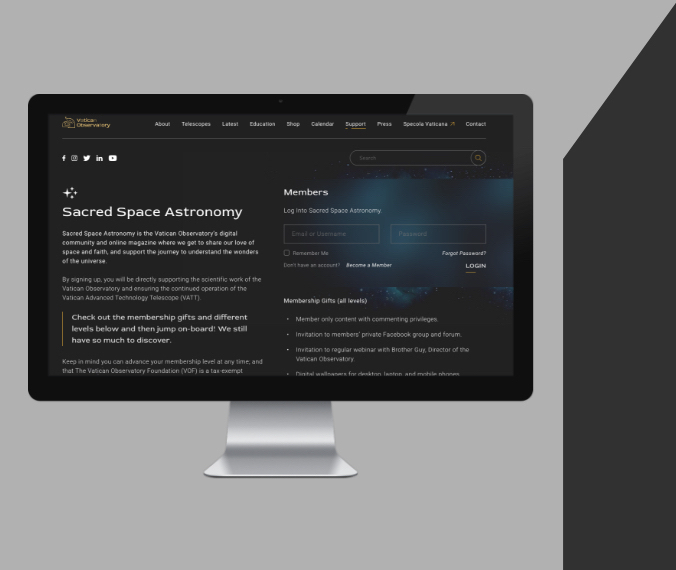I hope you had better luck than I did seeing the transit of Mercury… a good portion of North America was shrouded in clouds – I got several inches of snow!
Even the website I pointed readers to last week to view the transit online was not broadcasting due to clouds. I ended up watching it on NASA’s Solar Dynamics Observatory’s (SDO) Eclipse website – clouds are never a problem for the SDO.
 Mercury Transit Nov. 11, 2019 seen in multiple frequencies from the Solar Dynamics Observatory. Images courtesy of NASA/SDO and the AIA, EVE, and HMI science teams, edited by Bob Trembley.
Mercury Transit Nov. 11, 2019 seen in multiple frequencies from the Solar Dynamics Observatory. Images courtesy of NASA/SDO and the AIA, EVE, and HMI science teams, edited by Bob Trembley.
Venus and Jupiter appear very low and Saturn appears high in the southwestern sky after sunset this week over the week. Jupiter moves slightly towards the horizon, and Venus moves slightly southward toward Jupiter.
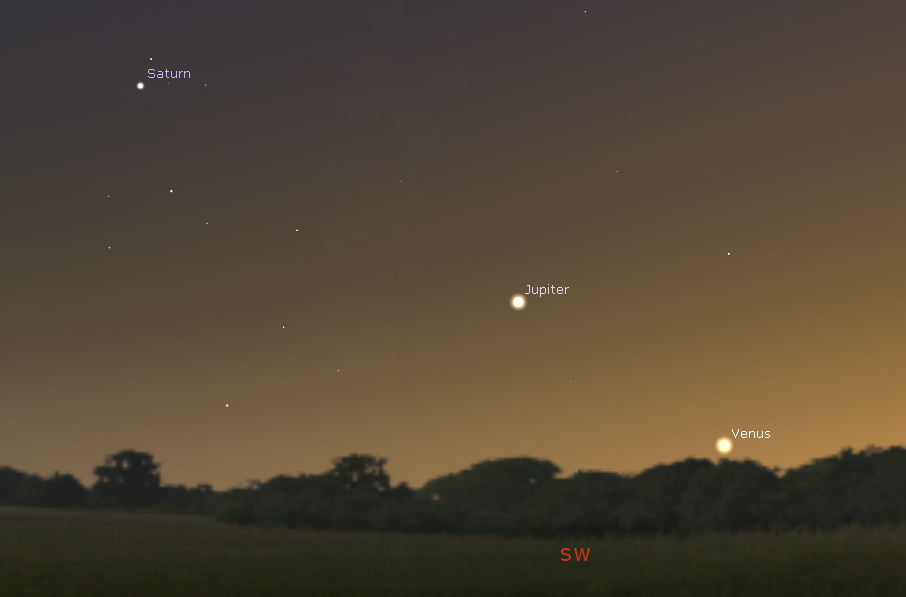 Venus and Jupiter low and Saturn high above the southwestern horizon after sunset on Nov. 12th. Credit: Stellarium / Bob Trembley
Venus and Jupiter low and Saturn high above the southwestern horizon after sunset on Nov. 12th. Credit: Stellarium / Bob TrembleyBy the beginning of next week Mercury returns, appearing low and Mars a bit higher above the eastern horizon before sunrise this week. If you are having trouble spotting Mercury, you can use Mars and the star Spica to star-hop in the general direction of Mercury.
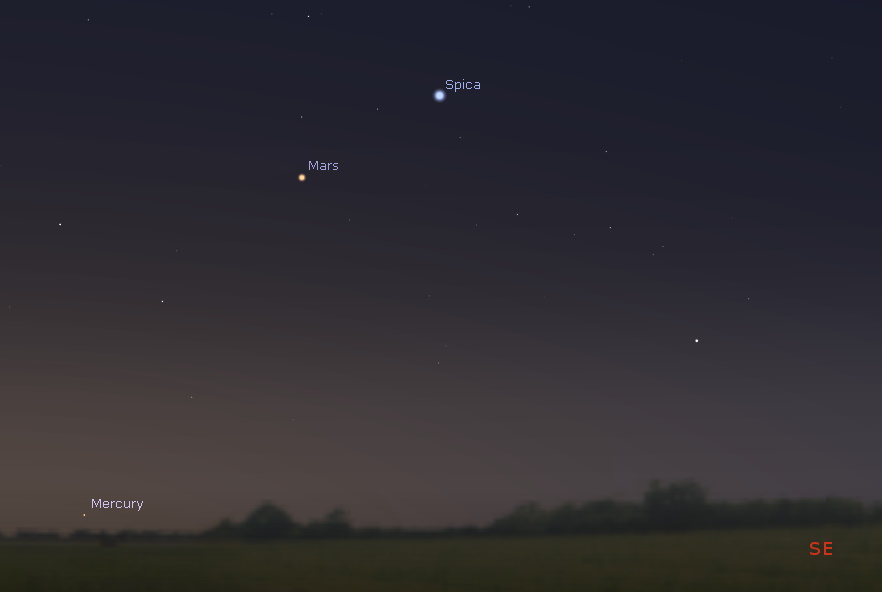 The planets Mercury and Mars are low on the southeastern horizon before dawn this week. Credit: Stellarium / Bob Trembley
The planets Mercury and Mars are low on the southeastern horizon before dawn this week. Credit: Stellarium / Bob TrembleyThe Moon appears high in the sky at midnight, and moves across the sky from south to east this week.
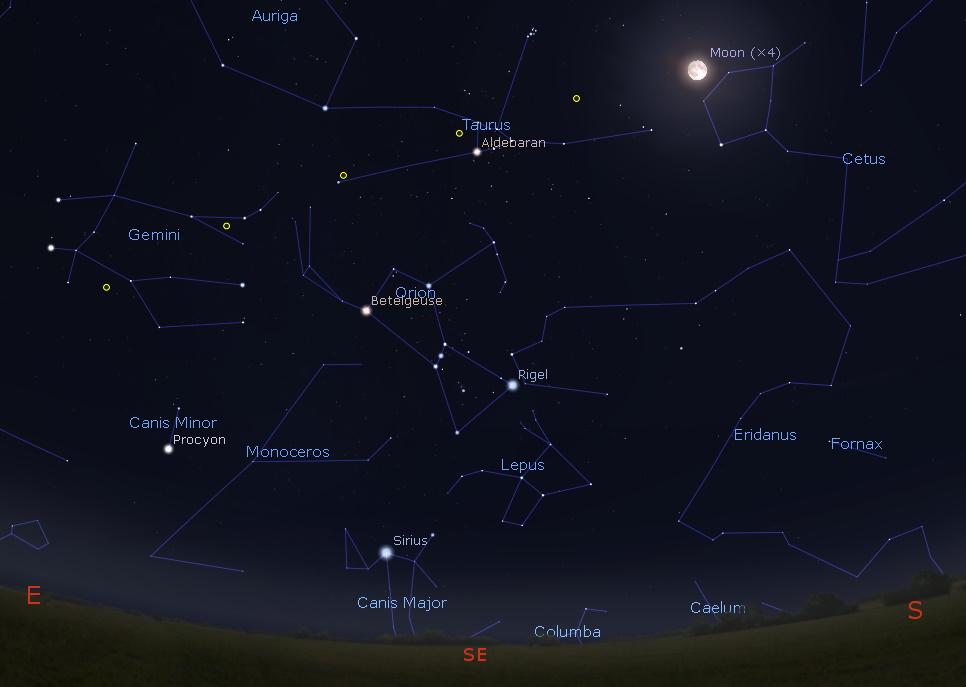 The Moon moving through the constellations Taurus, and Gemini this week. Credit: Stellarium / Bob Trembley
The Moon moving through the constellations Taurus, and Gemini this week. Credit: Stellarium / Bob TrembleyThe Moon appears near the star Aldebaran at midnight on Nov. 14th.
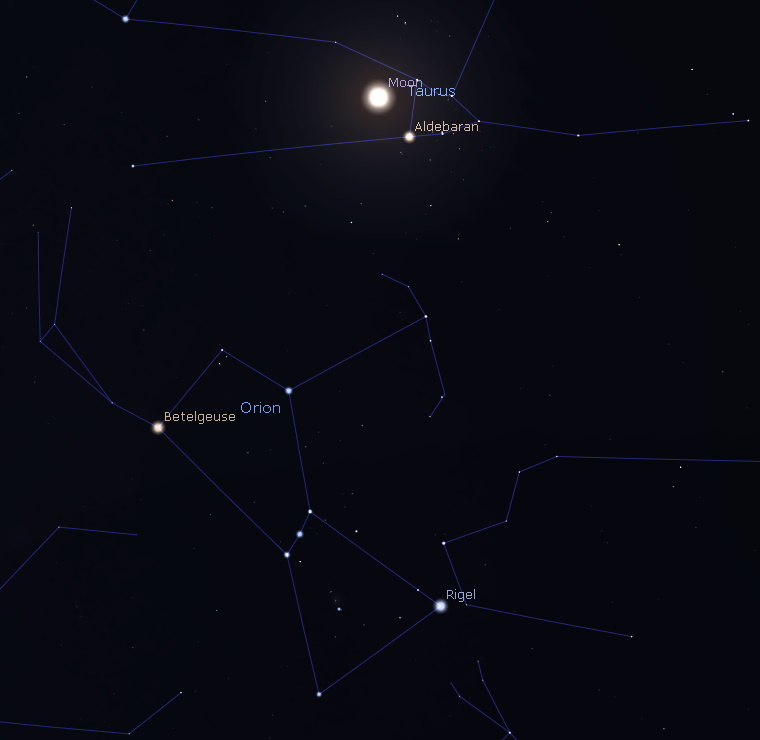 The Moon near the star Aldebaran in the constellation Taurus on Nov. 14th at midnight. Credit: Stellarium / Bob Trembley
The Moon near the star Aldebaran in the constellation Taurus on Nov. 14th at midnight. Credit: Stellarium / Bob TrembleyThe Moon appears near the star Pollux at midnight on Nov. 17th.
From the southern hemisphere, the planets that appear across our southwestern sky near sunset appear nearly vertically!
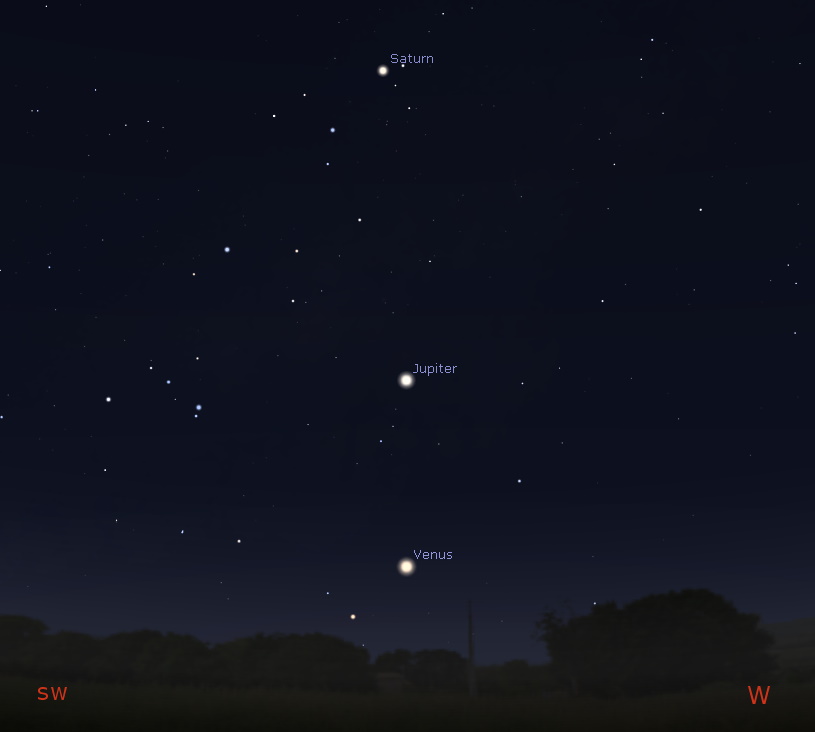 The planets seen from Tual, Indonesia in the southern hemisphere 5:00 PM Nov. 12, 2019 . Credit: Stellarium / Bob Trembley
The planets seen from Tual, Indonesia in the southern hemisphere 5:00 PM Nov. 12, 2019 . Credit: Stellarium / Bob Trembley

The Moon is Full, rising at sunset, visible high in the sky around midnight, and visible all night.
After Nov. 12th, the Moon will be a waning gibbous heading towards last quarter on Nov. 19th; before the Nov. 19th, the Moon will rise after sunset, be visible high in the sky after midnight, and be visible to the southwest after sunrise.
 The Moon from Nov. 12-18, 2019. Visualizations by Ernie Wright / NASA’s Scientific Visualization Studio.
The Moon from Nov. 12-18, 2019. Visualizations by Ernie Wright / NASA’s Scientific Visualization Studio.Moon News

The Sun has a spot; a new sunspot is emerging from the Sun’s limb. At the time of this writing, the sunspot has no AR designation.
Coronal holes appear at both poles, and a weird smaller coronal is snaking its way up from te south pole.
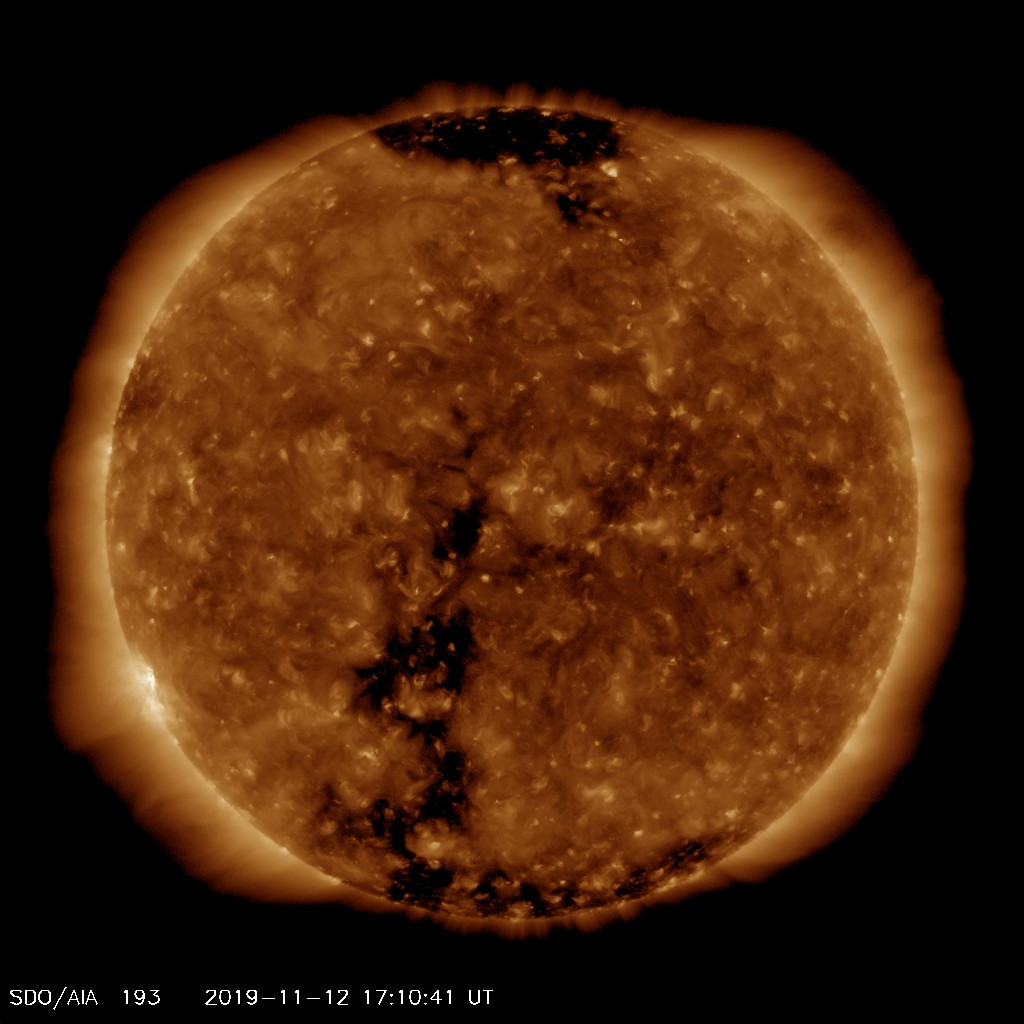 Sun in 193 angstroms (extreme ultraviolet) Nov. 12, 2019. Image courtesy of NASA/SDO and the AIA, EVE, and HMI science teams.
Sun in 193 angstroms (extreme ultraviolet) Nov. 12, 2019. Image courtesy of NASA/SDO and the AIA, EVE, and HMI science teams.A a couple large prominences on the Sun’s limb today – look at that monster on the upper right! The unnamed Active Region can be seen on the lower left.
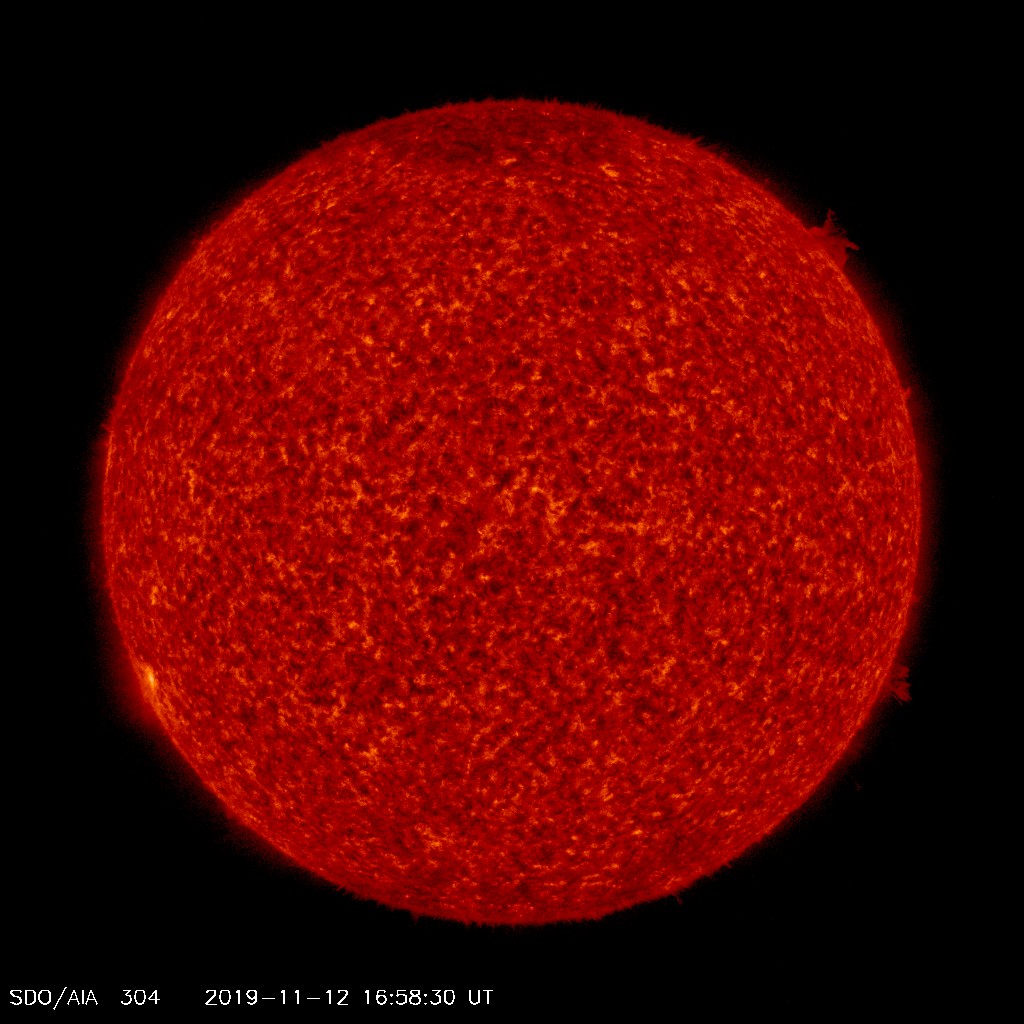 Sun in 304 angstroms (extreme ultraviolet) Nov. 12, 2019. Image courtesy of NASA/SDO and the AIA, EVE, and HMI science teams.
Sun in 304 angstroms (extreme ultraviolet) Nov. 12, 2019. Image courtesy of NASA/SDO and the AIA, EVE, and HMI science teams.https://www.facebook.com/photo.php?fbid=10218266578369620&set=gm.2773940582617268&type=3&theater&ifg=1
The solar wind speed is 349.1 km/sec (↓), with a density of 0.1 protons/cm3 (↓) at 1700 UT.
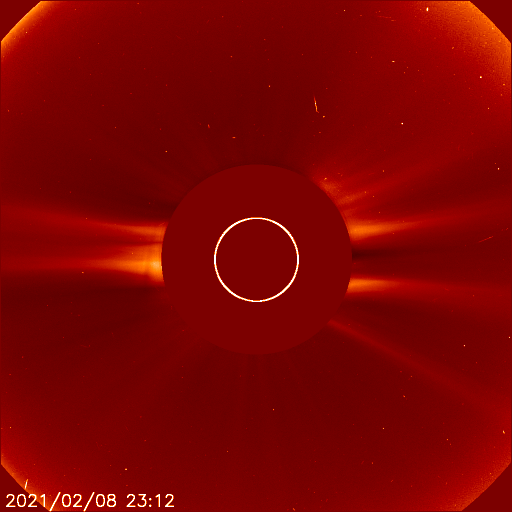 Animated LASCO C2 Coronograph showing the solar corona above the Sun’s limb (the white circle). Credit: NASA/JPL-Caltech
Animated LASCO C2 Coronograph showing the solar corona above the Sun’s limb (the white circle). Credit: NASA/JPL-CaltechYou can create your own time-lapse movies of the Sun here: AIA/HMI Browse Data.
You can browse all the SDO images of the Sun from 2010 to the present here: Browse SDO archive.
Sun News
 Upcoming Earth-asteroid encounters:
Upcoming Earth-asteroid encounters:
| Asteroid |
Date(UT)
|
Miss Distance
|
Velocity (km/s)
|
Diameter (m)
|
| 2019 VN |
2019-Nov-11
|
3.1 LD
|
13.6
|
32
|
| 2010 JG |
2019-Nov-12
|
19.6 LD
|
14.9
|
235
|
| 2019 UB14 |
2019-Nov-12
|
4.9 LD
|
15.4
|
22
|
| 2019 UH1 |
2019-Nov-13
|
9.5 LD
|
9.1
|
50
|
| 2019 UN12 |
2019-Nov-13
|
3.8 LD
|
28.8
|
141
|
| 2019 VX |
2019-Nov-13
|
4.1 LD
|
10.8
|
31
|
| 2019 UE8 |
2019-Nov-15
|
7.7 LD
|
6.6
|
27
|
| 2019 UR2 |
2019-Nov-18
|
18 LD
|
13.4
|
126
|
| 2019 UK6 |
2019-Nov-20
|
15.4 LD
|
7.7
|
63
|
| 481394 |
2019-Nov-21
|
11.3 LD
|
7.9
|
372
|
| 2019 VK |
2019-Nov-21
|
5.8 LD
|
7.6
|
43
|
| 2008 EA9 |
2019-Nov-23
|
10.5 LD
|
2.2
|
10
|
| 2019 VF1 |
2019-Nov-25
|
13.4 LD
|
17.3
|
87
|
| 2017 AP4 |
2019-Dec-03
|
8.5 LD
|
7.5
|
15
|
| 2018 XW2 |
2019-Dec-07
|
17.4 LD
|
13
|
28
|
| 216258 |
2019-Dec-20
|
15.3 LD
|
11.8
|
324
|
| 2013 XY20 |
2019-Dec-21
|
18.4 LD
|
1.9
|
28
|
| 2017 XQ60 |
2019-Dec-22
|
11 LD
|
15.6
|
47
|
| 310442 |
2019-Dec-26
|
19 LD
|
12.3
|
372
|
| 2019 AE3 |
2020-Jan-02
|
4.9 LD
|
8.2
|
13
|
Notes: LD means “Lunar Distance.” 1 LD = 384,401 km, the distance between Earth and the Moon. Red highlighted entries are asteroids that either pass very close, or very large with high relative velocities to the Earth. Table from SpaceWeather.com
Potentially hazardous asteroids: 2018 (last updated Oct. 1, 2019)
Minor Planets discovered: 839,778 (-141)
Asteroid News: Newly Named Asteroids
(188693) Roosevelt = 2005 TO14
Discovered 2005 Oct. 3 by R. A. Kowalski at the Catalina Sky Survey.
Theodore Roosevelt (1858–1919) was the 26th President of the United States and is one of the most admired leaders in American history. Among his many accomplishments he is well known for his conservationism, having established the US Forest Service, five National Parks, 18 National Monuments, and 150 National Forests.
(35394) Countbasie = 1997 XD9
Discovered 1997 Dec. 7 at Caussols.
William James “Count” Basie (1904–1984) was an American jazz pianist, organist, bandleader and composer. One of the greatest jazz musicians of the 20th century,
he founded the Count Basie Orchestra in 1935 and left an impressive discography.
(5773) Hopper = 1989 NO
Discovered 1989 July 2 by E. F. Helin at Palomar.
Grace Hopper (1906–1992) was an American computer scientist and rear admiral in the United States Navy. A pioneer in programming, she invented one of the first compilers and was instrumental in the development of COBOL. She was awarded over 40 honorary degrees in her lifetime, as well as the Presidential Medal of Freedom in
2016.
(6486) Anitahill = 1991 FO
Discovered 1991 Mar. 17 by E. F. Helin at Palomar.
Anita Hill (b. 1956) is an American attorney and professor. Her testimony in the confirmation hearings of US Supreme Court Justice Clarence Thomas inspired
generations of women to speak out against harassment and led to more women in US politics. She continues to advocate for human rights.
From: https://minorplanetcenter.net/iau/ECS/MPCArchive/2019/MPC_20191108.pdf

On Nov. 12, 2019, the NASA All Sky Fireball Network reported 13 fireballs.
(10 sporadics, 3 northern Taurids)
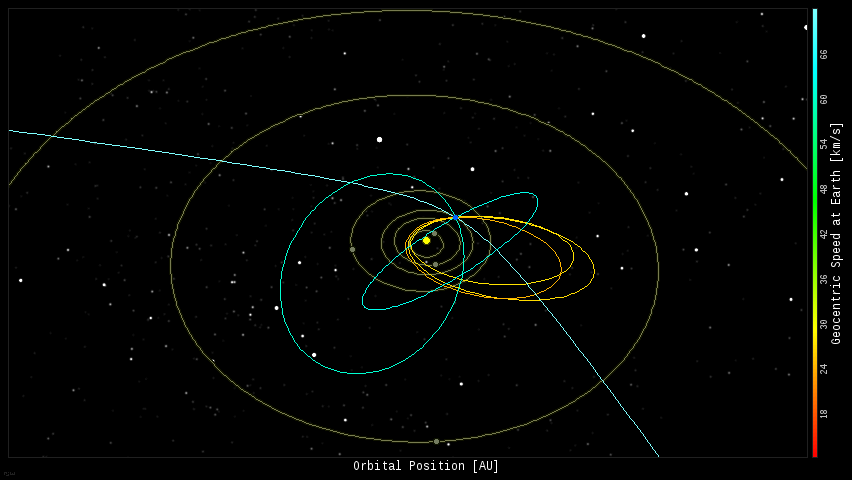 In this diagram of the inner solar system, all of the fireball orbits intersect at a single point–Earth. The orbits are color-coded by velocity, from slow (red) to fast (blue). From: Spaceweather.com
In this diagram of the inner solar system, all of the fireball orbits intersect at a single point–Earth. The orbits are color-coded by velocity, from slow (red) to fast (blue). From: Spaceweather.comFireball News
https://twitter.com/CindyParres/status/1194096477838163970

 Position of the planets and a couple spacecraft in the inner solar system:
Position of the planets and a couple spacecraft in the inner solar system:
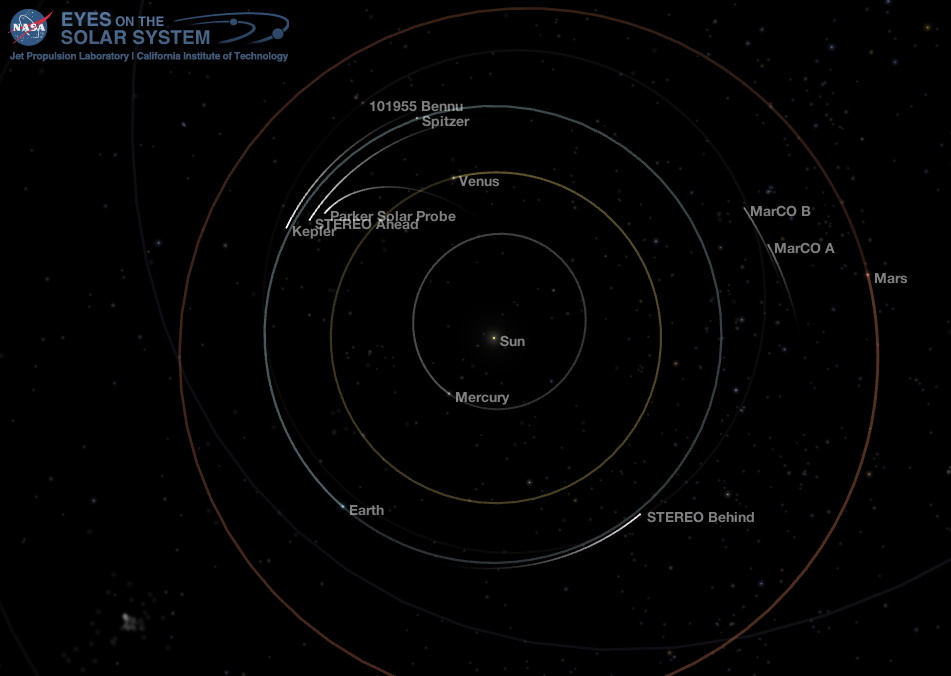 Position of the planets and some spacecraft in the inner solar system, Nov. 12, 2019. Credit: NASA Eyes on the Solar System / Bob Trembley.
Position of the planets and some spacecraft in the inner solar system, Nov. 12, 2019. Credit: NASA Eyes on the Solar System / Bob Trembley.Position of the planets and a couple bodies in the middle solar system:
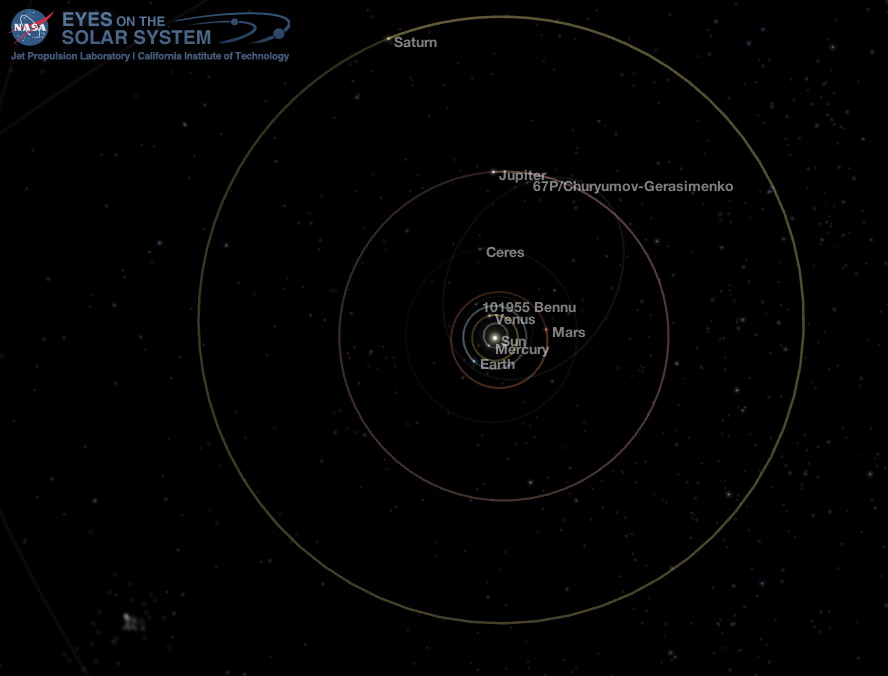 Position of the planets in the middle solar system, Nov. 12, 2019. Credit: NASA Eyes on the Solar System / Bob Trembley.
Position of the planets in the middle solar system, Nov. 12, 2019. Credit: NASA Eyes on the Solar System / Bob Trembley.Position of the planets and a several bodies in the outer solar system, asteroid 471143 Dziewanna is highlighted:
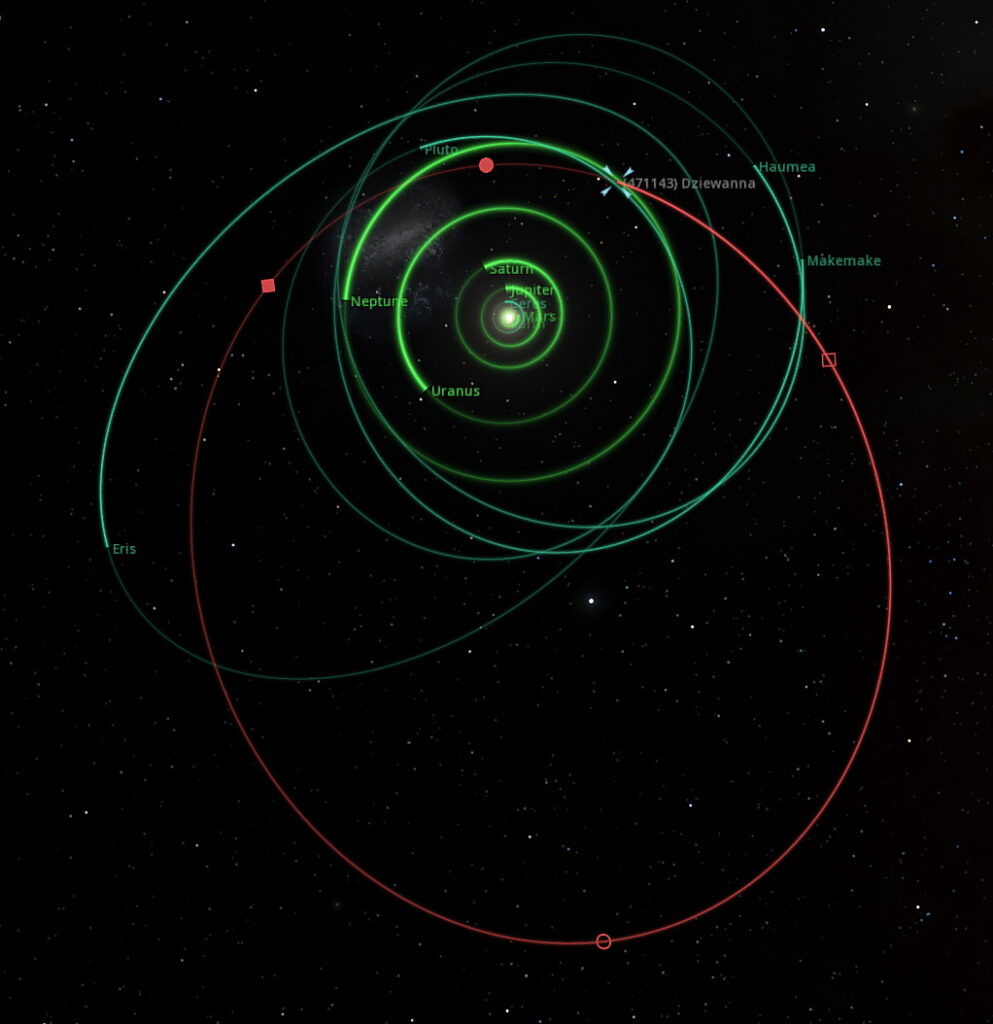 Outer Solar System Nov. 12, 2019 – orbit of asteroid 471143 Dziewanna is highlighted in red. Credit: SpaceEngine / Bob Trembley
Outer Solar System Nov. 12, 2019 – orbit of asteroid 471143 Dziewanna is highlighted in red. Credit: SpaceEngine / Bob TrembleyAsteroid 471143 Dziewanna
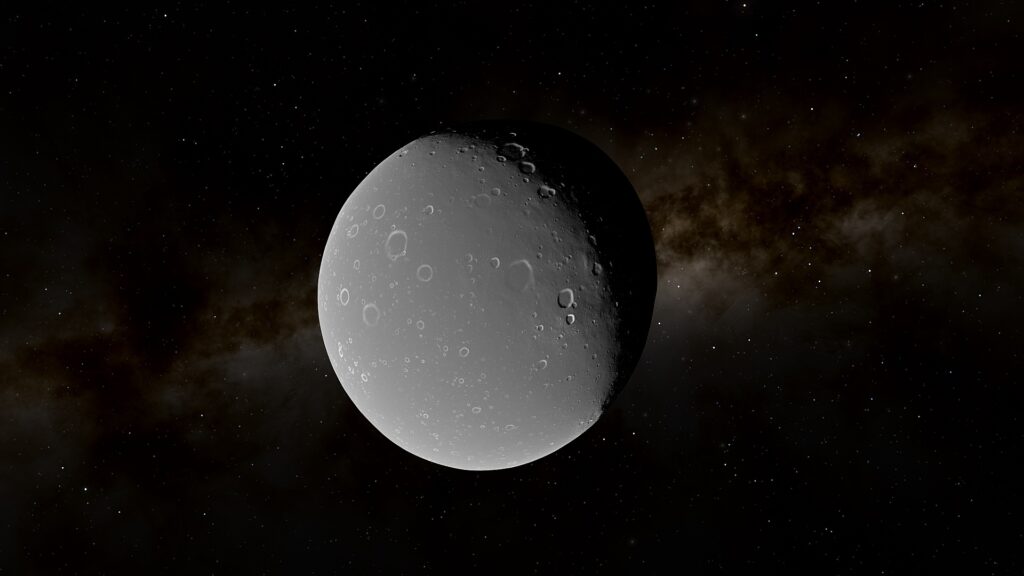 Artist conception of asteroid and possible dwarf planet 471143 Dziewanna. Credit: SpaceEngine / Bob Trembley.
Artist conception of asteroid and possible dwarf planet 471143 Dziewanna. Credit: SpaceEngine / Bob Trembley.471143 Dziewanna /dʒɪˈvænə/, provisional designation 2010 EK139, is a trans-Neptunian object in the scattered disc, orbiting the Sun in the outermost region of the Solar System.
It was discovered on 13 March 2010, by astronomers Andrzej Udalski, Scott Sheppard, Marcin Kubiak and Chad Trujillo at the Las Campañas Observatory in Chile. The discovery was made during the Polish OGLE project of Warsaw University. Based on its absolute magnitude and assumed albedo, it is possibly a dwarf planet with a calculated diameter of approximately 470 kilometers.
It was named after Devana (Polish form: Dziewanna), a Slavic goddess of the wilderness, forests and the hunt. – Wikipedia
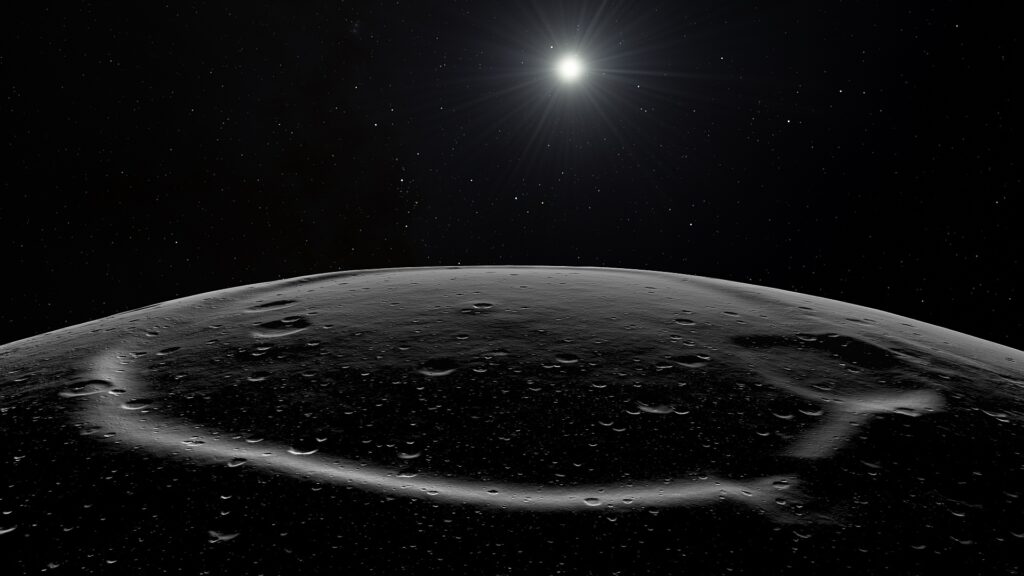 Artist conception from above the surface of asteroid 471143 Dziewanna. Credit: SpaceEngine / Bob Trembley.
Artist conception from above the surface of asteroid 471143 Dziewanna. Credit: SpaceEngine / Bob Trembley.NASA’s Interactive Real-Time Web-based Orrery:
[iframe src=’https://eyes.nasa.gov/apps/orrery/’ height=600 percent=100 style=””]
OSIRIS-REx Asteroid Sample Return Mission – 2019 Commemorative Poster
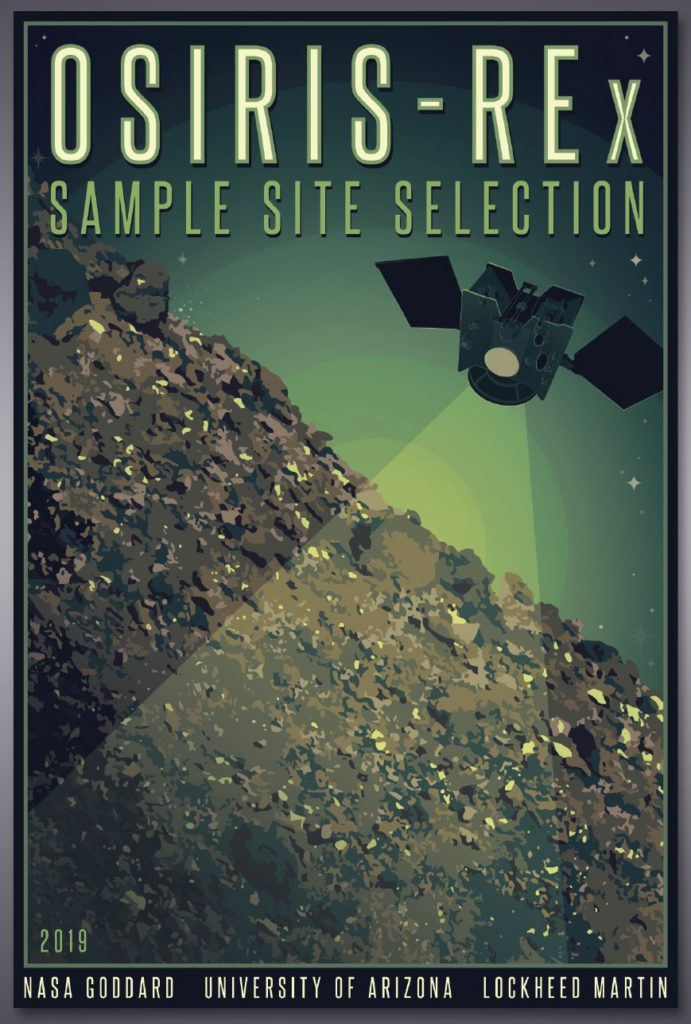
Available from: https://www.asteroidmission.org/wp-content/uploads/2019/11/Sample-Site-Selection-Poster-2019.pdf
NASA InSight Mars Lander
Falcon Launch Dove
When I saw this image, it got an immediate “Oh! WOW!” So I HAD to post it:
